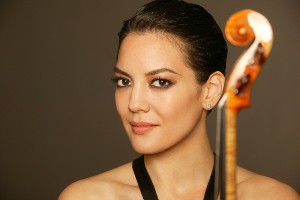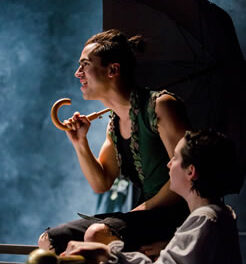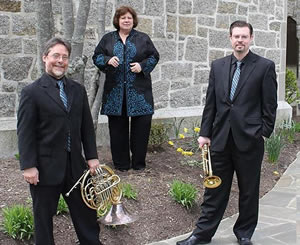Since Independence Day is a major patriotic holiday in the United States, there was an air of expectation in Whittington-Pfohl Auditorium that we would hear a truly rip-snort’n version of “The Star-Spangled Banner” or at least an impassioned rendering of “Oh Canada.” Alas, we didn’t get either of those, but we did get a boatload of brass tunes, a ton of showmanship, and enough rain to break out the bumbershoots while inside the shed!
Canadian Brass was formed as a chamber ensemble in Toronto, Ontario, in 1970. At the time it was a rather avant-garde concept that met with immediate success. However I can see where after thirty years of hammering the road, playing the same Sousa march for the umpteenth time, and riding the same bus can get on your nerves, so these guys have put a lot of fun and spark into the act to provide a little challenge and entertainment.
For example, the final piece on the program consisted of highlights from Georges Bizet’s Carmen. The objective was to present the entire opera in themes with each player wearing a wig or hat to represent a character. It seems the main sticking point with the opera, at least from the Canadian view, is that there is a bullfighter character but no bull. So the tuba player donned a tail and set of horns to “right this grievous omission.” Then they played five movements – the Overture, “Habanera,” Interlude, “Seguidilla,” and the “Toreador Song” – in such a rousing and fun manner, never missing a note or beat, that they earned a standing ovation from the full house.
The program included a toccata by Girolamo Frescobaldi (1583-1643) and the Rondo from the Quintet, K.407, for horn and strings by Mozart, performed brilliantly by Bernard Scully on horn. Then came a pair of similar sounding yet distinctly different works – “Bandinerie,” from J.S. Bach’s Second Orchestral Suite, and Canzona by Giovanni Gabrieli (the first to write for brass) – using antiphonal techniques with two trumpets and the tuba out in the audience while the horn and trombone played from the stage.
The lighter jazz fare was represented by Bramwell Tovey’s four-movement Santa Barbara Sonata (“Cakewalk on a Tight Rope,” “Preacher on the Pier,” “Magic Horn” and “State Street Stomp”) and a Fats Waller Tribute with “Lookin’ Good, but Feelin’ Bad,” “Loungin’ at the Waldorf,” and “Handful of Keys.” There was also a Glenn Miller set of “Moonlight Serenade,” “String of Pearls,” “American Patrol,” “At Last,” and “In the Mood,” with a stray “Danny Boy” tossed in for good measure. Here, each selection inspired some segments of the audience to sing along.
But the most popular set was a through-arranged medley of works by John Phillip Sousa ending with “The Stars and Stripes Forever.” As I mentioned in the “Black Watch and Welsh Guards” article earlier this year, to convey the majesty of patriotic works you need full-on brass, and they can’t miss. I’m talking about where the hair on the back of your neck stands up! These guys didn’t miss all night. It was a clinic of brass playing, perfect intonation, ensemble flexibility, and fun staging that kept everyone engaged for the entire program.
Ronald Romm, trumpet, Gene Watts, trombone, and Chuck Daellenbach, tuba and Main Spokesperson, are all original members of the group. Ryan Anthony, trumpet, and Bernard Scully, horn, are the young newcomers. This group has toured the world, performed with major symphony orchestras and expanded the repertoire for brass ensembles in ways that have already made them legends.
One of my classmates from school was a part time illustrator for fun. He would draw humorous caricatures of brass instruments and always include a “clam release valve.” This is where all the wrong notes (clams) go instead of out through the main bell. I showed one of these drawings to my girlfriend. She said, “Yeah, he’s not well.”
I’d have to say the same is true of the Canadian Brass. And they are having so much fun!













